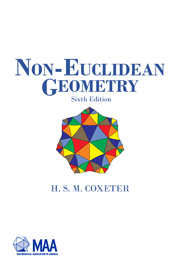Book contents
- Frontmatter
- PREFACE TO THE SIXTH EDITION
- Contents
- I THE HISTORICAL DEVELOPMENT OF NON-EUCLIDEAN GEOMETRY
- II REAL PROJECTIVE GEOMETRY: FOUNDATIONS
- III REAL PROJECTIVE GEOMETRY: POLARITIES, CONICS AND QUADRICS
- IV HOMOGENEOUS COORDINATES
- V ELLIPTIC GEOMETRY IN ONE DIMENSION
- VI ELLIPTIC GEOMETRY IN TWO DIMENSIONS
- VII ELLIPTIC GEOMETRY IN THREE DIMENSIONS
- VIII DESCRIPTIVE GEOMETRY
- IX EUCLIDEAN AND HYPERBOLIC GEOMETRY
- X HYPERBOLIC GEOMETRY IN TWO DIMENSIONS
- XI CIRCLES AND TRIANGLES
- XII THE USE OF A GENERAL TRIANGLE OF REFERENCE
- XIII AREA
- XIV EUCLIDEAN MODELS
- XV CONCLUDING REMARKS
- APPENDIX: ANGLES AND ARCS IN THE HYPERBOLIC PLANE
- BIBLIOGRAPHY
- INDEX
X - HYPERBOLIC GEOMETRY IN TWO DIMENSIONS
- Frontmatter
- PREFACE TO THE SIXTH EDITION
- Contents
- I THE HISTORICAL DEVELOPMENT OF NON-EUCLIDEAN GEOMETRY
- II REAL PROJECTIVE GEOMETRY: FOUNDATIONS
- III REAL PROJECTIVE GEOMETRY: POLARITIES, CONICS AND QUADRICS
- IV HOMOGENEOUS COORDINATES
- V ELLIPTIC GEOMETRY IN ONE DIMENSION
- VI ELLIPTIC GEOMETRY IN TWO DIMENSIONS
- VII ELLIPTIC GEOMETRY IN THREE DIMENSIONS
- VIII DESCRIPTIVE GEOMETRY
- IX EUCLIDEAN AND HYPERBOLIC GEOMETRY
- X HYPERBOLIC GEOMETRY IN TWO DIMENSIONS
- XI CIRCLES AND TRIANGLES
- XII THE USE OF A GENERAL TRIANGLE OF REFERENCE
- XIII AREA
- XIV EUCLIDEAN MODELS
- XV CONCLUDING REMARKS
- APPENDIX: ANGLES AND ARCS IN THE HYPERBOLIC PLANE
- BIBLIOGRAPHY
- INDEX
Summary
Ideal elements. As a sufficient set of axioms for plane hyperbolic geometry (based on point, intermediacy, and congruence) we may take 8.311, 8.313-8.317, 8.32, 9.11-9.15, and 9.61 (along with the denial of 8.318). It is, of course, possible to prove such theorems as 8.92 and 9.69 without using ideal elements. But the advantage of points at infinity has already been seen, and the reader will find that many propositions can be handled very expeditiously with the aid of the powerful machinery of projective geometry.
By considering flat pencils of parallels (namely, lines parallel to a given ray) and flat pencils of ultra-parallels (namely, lines perpendicular to a given line) it is possible to introduce ideal points into the plane, and to distinguish certain classes of them as forming ideal lines. But the three-dimensional treatment of Chapters VIII and IX is more satisfactory, as it allows all kinds of point, ordinary and ideal, to be covered by a single definition (§§8.6, 8.7). Accordingly, we have used Axioms 8.318, 8.319, and defined the absolute polarity in terms of reciprocal pencils of planes (§9.7), obtaining an oval quadric as the locus of points at infinity. When we restrict consideration to a single ordinary plane, the points at infinity that remain form a conic (the section of the quadric by the plane). From now on, we shall reserve the name Absolute for this conic, as we shall be concerned almost entirely with two-dimensional geometry.
- Type
- Chapter
- Information
- Non-Euclidean Geometry , pp. 199 - 212Publisher: Mathematical Association of AmericaPrint publication year: 1998

